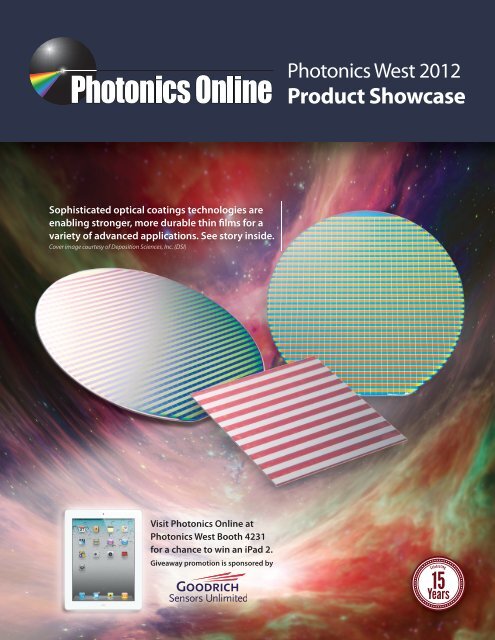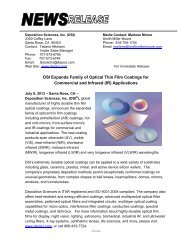Photonics Online - Deposition Sciences, Inc.
Photonics Online - Deposition Sciences, Inc.
Photonics Online - Deposition Sciences, Inc.
Create successful ePaper yourself
Turn your PDF publications into a flip-book with our unique Google optimized e-Paper software.
<strong>Photonics</strong> <strong>Online</strong><strong>Photonics</strong> West 2012Product ShowcaseSophisticated optical coatings technologies areenabling stronger, more durable thin films for avariety of advanced applications. See story inside.Cover image courtesy of <strong>Deposition</strong> <strong>Sciences</strong>, <strong>Inc</strong>. (DSI)Visit <strong>Photonics</strong> <strong>Online</strong> at<strong>Photonics</strong> West Booth 4231for a chance to win an iPad 2.Giveaway promotion is sponsored by15CelebratingYears
<strong>Photonics</strong> <strong>Online</strong>’s <strong>Photonics</strong> West Product ShowcaseEnhanced Optical CoatingTechnologies Enable StrongerThin FilmsBy Eric W. Kurman, Engineering Manager, Sr. Program Manager,<strong>Deposition</strong> <strong>Sciences</strong>, <strong>Inc</strong>. (DSI)Thin-film coating technologieshave been a critical enabler in manyindustries and application areas. Higherperformance,more durable, and moreruggedized optical thin film coatings arenow possible on an increasing numberof substrate form factors and withvarying coating types.Advanced deposition technologies areleading to new and expanded productareas. <strong>Deposition</strong> <strong>Sciences</strong>, <strong>Inc</strong>., (DSI)of Santa Rosa, CA, has developeda sophisticated coating depositionmachine called MicroDyn. It is anextremely versatile and innovativearchitecture for producing complex andhighly durable optical thin film coatings.Complex Filters On PolymerSubstratesOne product area that is benefitingfrom this new technology is complexfilters on polymer substrates. Whilesimple structures like antireflection(AR) coatings are widely availableon polymer optics, DSI is depositingdichroic, bandpass, and blocking filterson high-performance polymers. Thesesubstrate/coating combinations enablelightweight optics for defense andaerospace, as well as formed optics forlaser eye protection.The main challenge with polymer opticsis the great disparity in mechanicalproperties between substrate andcoating materials. Polymers do nothave nearly the hardness and abrasionresistance of glasses or semiconductors.Because of the physical thickness ofthe coating, it is “along for the ride” onany deformations the substrate mayexperience. Polymer coefficients ofthermal expansion can be orders ofmagnitude greater than the ceramicmaterials (oxides and fluorides) used incoatings. This limits thepermissible temperaturefor a polymer opticin coating and postcoatingprocessing,which in turn canimpose a limit oncoating throughput.Mechanical forcesused in fabrication andassembly will causemuch larger deformationon a polymer optic thana conventional glasssources.optic. Adhesion onpolymers is a challenge in itself, sincethe chemical mechanisms of adhesiondiffer. Most polymer optics need anabrasion-resistant hard coat becausescratch and scuff resistance of the nativepolymer is inadequate. These hard coatsoften contain inorganic componentsthat improve the adhesion by making itstronger. Selection and preparation ofthe hard coat is critical. Even with theabove-mentioned mechanical, abrasion,and hardness limitations in mind, manyapplications are good candidates forcoater polymer optics.Replacement Of Tungsten-HalogenLamps With ‘White’ LEDsHigh-performance lighting applicationsare undergoing a transformation asenergy efficiency becomes continuallymore important. At DSI, a subsidiary ofAdvanced Lighting Technologies, themost important trend we see is theprogressive replacement of tungstenhalogenlamps with “white” lightemittingdiodes (LEDs). Tungsten lampstypically run at 2500K with a continuous,gray-body spectral distribution.In contrast, the spectral distributions of“white” LED assemblies usually combinea blue LED with a yellow-emittingphosphor (see figure 1). Often, ratherFigure 1: Chart showing comparison of “white” LED (blue line) with CIEIlluminant A (gold line). MicroDyn is an extremely versatile and innovativearchitecture for producing complex and highly durable optical thin filmcoatings cost effectively and on a large scale to work with a variety of lightthan using a specific color of LED foran application, such as an airport signallight, a white light source is combinedwith a color filter. This means that adifferent approach must be used fora color filter for use with an LED thanfor a tungsten-halogen lamp. SinceLEDs deliver a relatively small, highbrightnesssource of illumination,reflectors and diffusers are often used torealize a desired light distribution. Colorcorrection can become important in thereflectors to yield the desired “daylight,”“soft white,” or other color temperature2<strong>Photonics</strong> <strong>Online</strong> ■ www.photonicsonline.com
<strong>Photonics</strong> <strong>Online</strong>’s <strong>Photonics</strong> West Product Showcaseoutput. These color corrections tendto be high-end applications since,primarily due to the automotiveindustry, industrial metallizing is welldevelopedand readily available at lowcost for simple reflectors.Patterned, Multispectral BandpassCoatings With High Surface QualityRecently, DSI has produced patterned,multispectral bandpass coatings withhigh surface quality. The finished opticsembody techniques such asprecision alignment of coatedfeatures to the part, steeprejectionbandpass coatings,and handling and processingto meet 20-10 to 10-5 surfacequality per MIL-PRF-13830B.These optics are made usingmultiple lithographic patterningand thin-film deposition steps.Since the process is complexwith a variety of operations,custom tooling is needed forsecure handling of high-valueparts during the inspectionand coating steps and theapplication of lithographyfeatures. The filters often must exhibitstable spectral response through arange of operating conditions, such asthermal environments from ambient tocryogenic temperatures.The presence of multiple filter typesrequires some subtle design techniques.One such is providing an AR coatingand avoiding an extra patterning stepby integrating the AR design into theoverlying filter type. Another challengeis maintaining a narrow transition zoneat the border of a filter area or at thejunction where two different filters abutone another. Bandpass or edge-typefilters of reasonable steepness can beseveral microns thick. DSI has been ableto hold transition regions to well below50 microns in these areas. Absoluteplacement tolerance of 0.7% to 0.8%for an edge is within current practice.However, additional considerations canmake this challenging: the temperaturerange of performance (which takesup a good bit of placement tolerance)and the fact that these filters are beingdeposited on expensive substrates thathave already had a large amount ofvalue added (due to multiple patterningand coating steps). For inexpensivesubstrates, it is possible to use theFigure 2: Stronger, more durable patterned optical filter manufactured by<strong>Deposition</strong> <strong>Sciences</strong>, <strong>Inc</strong>., using the MicroDyn coating deposition methodstatistical distribution of manufacturingto advantage by coating a number ofparts and selecting the ones with thedesired spectral features. For highvalueapplications, a stable, predictablecoating process yielding deterministicresults is a requirement.Broadband AR CoatingsOn Synthetic Sapphire ForMultispectral ImagingAnother optical thin film area thatwill benefit from new technology isbroadband AR coatings on syntheticsapphire (Al2O3) for multispectralimaging, especially in unmanned aircraftsystems (UAS) and remote-sensingapplications. Sapphire is an attractivesubstrate for several reasons:• Hardness; highly resistant toscratching and abrasion• Strength, especially thermal shockresistance• High thermal conductivity for anonconductor (even better thancopper at cryogenic temperatures)• Transparency from below 200 nmto above 5 micronsSapphire is a highly compatiblesubstrate with sputter depositionprocesses, especially if the“c-cut” variety is used. Froma coatings standpoint, it isdifficult to take advantage ofthe spectral transparency rangebecause of the limitations ofinterference coatings. As arule of thumb, a multilayer ARhas good performance overa ~2:1 wavelength range.Larger wavelength spansrequire compromises in theperformance of the coating.This usually means selectingsubranges that are importantin the final application. Thesemight be determined byfactors such as laser wavelengths,visible color (VIS) imaging, or specificdetector wavelengths. The coatingis then optimized for low reflectancein these regions while allowing reliefin other regions. This is the approachthat DSI has taken in our recentlyreleased broadband AR for sapphire.The VIS spectral region is particularlyattenuated, while the MWIR region hasless performance (although about halfthe reflectance of an uncoated optic).In conclusion, existing equipment andprocess technology is being adaptedto a progressively larger suite ofapplications to the benefit of optics andrelated industries. For more information,please visit www.depsci.com.www.photonicsonline.com ■ <strong>Photonics</strong> <strong>Online</strong> 3




